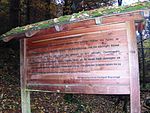Walkenried Abbey
1127 establishments1542 establishments in the Holy Roman Empire1648 disestablishmentsAbbeys and churches in the HarzChristian monasteries disestablished in the 17th century ... and 9 more
Christian monasteries established in the 12th centuryCistercian monasteries in GermanyImperial abbeysLothair III, Holy Roman EmperorLutheran churches in Lower SaxonyLutheran monasteries in GermanyMonasteries in Lower SaxonyReligious organizations established in the 1120sStates and territories established in 1542

Walkenried Abbey (German: Kloster Walkenried) was a Cistercian abbey located in the village of Walkenried in Lower Saxony, Germany. Founded in 1127 on the southern rim of the Harz mountain range, the remnants of the monastic complex since 2010 are part of the Upper Harz Water Regale World Heritage Site.
Excerpt from the Wikipedia article Walkenried Abbey (License: CC BY-SA 3.0, Authors, Images).Walkenried Abbey
Steinweg,
Geographical coordinates (GPS) Address Phone number Website External links Nearby Places Show on map
Geographical coordinates (GPS)
| Latitude | Longitude |
|---|---|
| N 51.583055555556 ° | E 10.619166666667 ° |
Address
ZisterzienserMuseum Kloster Walkenried
Steinweg 4a
37445
Lower Saxony, Germany
Open on Google Maps






